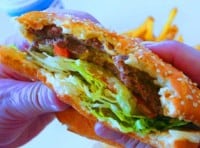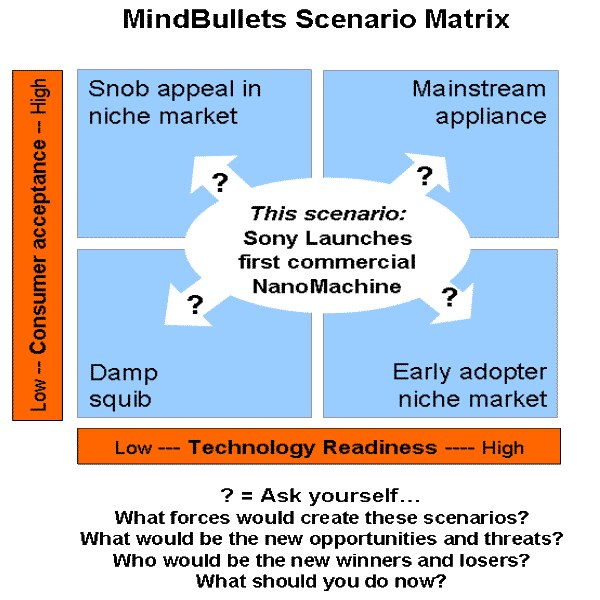BEAM ME UP A BURGER, SCOTTY!

Dinner from Sony – made atom by atom, molecule by molecule
- Dateline
- 9 February 2010
Pushing the trolley around the supermarket looks soon to become a thing of the past. You can now make almost anything you want, custom-built, right in your kitchen, using the new Sony Nano Assembler.
This gizmo is a microwave look-alike – at least superficially. By using the atoms available in your garbage, the Sony P1 is able to assemble anything – from a fresh lettuce to a spare part for your car.
The development is set to have a huge impact on consumer behavior. Wal-Mart has announced it will target to become an information business, replacing its food counters with a space age web site from which you can download the blueprints for all its food products – at less than 10% of the cost of the physical equivalent.
Like many new products, the performance of the Sony P1 disappoints. It is slow – it takes more than five minutes to assemble a crisp lettuce. Right now the product still costs more than three personal computers, but Sony expects the costs of these devices to drop by more than 30-40% per annum. It will also get faster; in three years, Sony expects the time to create a full meal to be down to minutes.
The new version of the P1 already being prototyped on the International Space Station, has new software features that will be available on the earth-bound version within 12 months.
You’ll be able to choose from six types of lettuce, complete with however many dewdrops you fancy!
ANALYSIS >> SYNTHESIS: How this scenario came to be
Nanoscience – manipulating and building devices atom-by-atom and molecule-by-molecule – is startling in its potential.
Imagine a box of Lego bricks, then think of these as ‘atoms’ that you could put together to make a molecule. Two hydrogen atoms and one atom of oxygen make water – the molecule H20. Early nanoassemblers worked on the molecular level: they picked up molecules and built more complex materials out of that.
But the dream was to perfect the making of commercial nanoassemblers that could perform this process at an atomic level. Nano scientists envisioned the picking up of atoms to create molecules that may not even exist in Nature. These might be new materials or ones copied from an atomic-level blueprint which could be downloaded to an assembler via the Internet.
Timeline
1999: First nanotechnology laboratory>
The $34 billion food giant, Kraft Foods, start the first nanotechnology research laboratory. Aware that conventional food science won’t keep the company competitive, and keen to maintain its leadership position, Kraft is amongst the first of the big food companies to begin nano research.
2000: NanoteK created
Kraft forms a consortium, NanoteK, which comprises leading universities and national research laboratories. Physicists, engineers and molecular scientists, not food scientists, carry out the development and research that might yield cutting-edge food technology. Several groups study nanoparticles that encapsulate certain flavors, colors or nutrients, and which could be zapped by a microwave or some other method, to deliver their payload. NanoteK’s focus is on the customization of food products.
2002: UK invests in nanoscience>
Nanoscience is getting serious attention. Governments around the world spend $2 billion on nanotech research this year. Building on the UK’s excellent scientific track record, the British Science & Innovations Minister announces a £90 million cash injection to aid nanotechnology research and facilities, following the government report, ‘New Dimensions for Manufacturing – a UK Strategy for Nanotechnology’.
2003: NASA prototype
NASA prototypes a molecular nanoassembler in the Space Shuttle program for the production of selected spare parts in space. Production is limited to the use of two metals and two plastics.
In food science, industry and academia can see the potential to build very well defined food structures from organic and non-organic materials through nanoassembly. Some have a vision of an abundant food supply to poorer countries: the generation of food by non-biological means using advanced nanotechnology, would ensure nutrition in countries with limited resources. For others it is the customization and personalization of products – foods that recognize a person’s profile, nutritional needs and allergies.
2005: Nanoassembler commecialised>
NASA and a consortium of private enterprises commercialise a molecular nanoassembler. Research is underway to develop atomic level assemblers. Multi-disciplinary networks of companies across the scientific spectrum band together to build a common architecture that can be used across all industries.
2006: Major failures
News reports of some major failures create negative publicity but the success of commercial molecular assemblers in the automotive and yachting world spur further investments. The public remains unconvinced.
2007: Hollywood blockbuster>
A major Hollywood sci-fi blockbuster features the design ideas of Sony, IBM and Dyson, including their versions of the application of nanoassemblers. The hype starts at the premiere and does not wane. The high cost of early machines still limits their usage but their presence in the homes of glitterati assures continued demand. The idea of food manufactured to your specific designs captures the imagination of the media and public alike – even though the practical reality is still some years off.
2008: Impact on retail companies
The food retail companies have begun to understand the implications nanoscience will have on consumer behavior. The likes of Marks & Spencer and Wal-Mart target to become information businesses, by replacing some of their food counters with space age web sites.
They see it working like this: the Sony P1 Nanoassembler connects direct to your Internet or Hypernet connection. If it’s a Cos lettuce you fancy, you click on the menu and select a supplier – Marks & Spencer, for example. The purchase is approved via your mobile phone PIN number at 10% of the price of the physical lettuce. Within seconds M&S downloads the molecular blueprint for the Cos lettuce. Assembly begins right in front of you, atom by atom.
But it’s not only the food companies that benefit. Think of the potential for spare automobile parts! If you need a new gasket for your vintage BMWz4, you can arrange the order within minutes on the BMW website, place the payment, download the molecular blueprint and watch the gasket assembly start. Then all you need is the open road!
2010: Sony P1 launched
Sony launches their first P1 – their first commercial product that they believe will establish the new standard for household appliances.

Links to related stories
- Nanotechnology: A new frontier in food science and technology, Rutgers University
- Prey - thriller by Michael Crichton
- Unbounding the Future: the Nanotechnology Revolution, Foresight Institute
- What is Nanotechnology? - UK Institute of Nanotechnology
- Nanotechnology is coming, feature by Ralph C. Merkle, VP Foresight Institute, September 2000
Warning: Hazardous thinking at work
Despite appearances to the contrary, Futureworld cannot and does not predict the future. Our Mindbullets scenarios are fictitious and designed purely to explore possible futures, challenge and stimulate strategic thinking. Use these at your own risk. Any reference to actual people, entities or events is entirely allegorical. Copyright Futureworld International Limited. Reproduction or distribution permitted only with recognition of Copyright and the inclusion of this disclaimer.